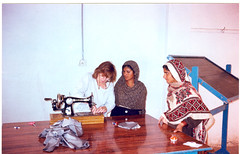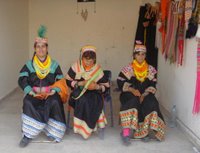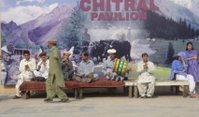Rural Environment
Tuesday, June 29, 2010

Labels: Images
posted by S A J Shirazi @ 10:58 AM,
,
![]()
![]()
Pride of Doll Makers
Monday, June 28, 2010

Tag: Doll Makers
Labels: Dolls of the World
posted by S A J Shirazi @ 8:51 AM,
,
![]()
![]()
Women Art Center
Sunday, June 27, 2010

Women Art Center
Labels: Education
posted by S A J Shirazi @ 9:16 AM,
,
![]()
![]()
Thatta Kedona Summer Camp in Hunza
Saturday, June 26, 2010

Related: Altit Baltit Forts Hunza
Labels: Education, Hunza, Old Women
posted by S A J Shirazi @ 12:55 PM,
,
![]()
![]()
Soft Tourism
Thursday, June 24, 2010
"Soft Tourism" is also a very vital part of the NGO activity since a long time. Volunteers, who are not engaged full-time in the project, spent a part of their time as "Tourists." What is more, thy pay for their own boarding and lodging which contributes to small income for the NGO. Some other guests also pay for the complete boarding and lodging expense and take back with them impressions of the village life in the rural Punjab.
Labels: Travel
posted by S A J Shirazi @ 8:54 AM,
,
![]()
![]()
My Cup of Doodh Patti
Monday, June 21, 2010
Labels: Doodh Patti
posted by S A J Shirazi @ 10:20 PM,
,
![]()
![]()
Volunteer at TTTC Tiles Workshop
Sunday, June 20, 2010

Labels: TTTC, Volunteers
posted by S A J Shirazi @ 9:52 AM,
,
![]()
![]()
Plagiarism
Saturday, June 19, 2010
Labels: Plagiarism
posted by S A J Shirazi @ 9:12 AM,
,
![]()
![]()
Invited to Join Fine Art of Blogging
Thursday, June 17, 2010
Join Fine Art of Blogging or read what those able bloggers are writing there.
Labels: Fine Arts of Blogging
posted by S A J Shirazi @ 7:24 AM,
,
![]()
![]()
Dolls Have Aways Been There
Wednesday, June 16, 2010
Even today they are used by many people as fetish. Today, the experts are not sure what was the first purpose of the dolls; as a toy, out of which the cult figure developed or the cult figure which became a toy.
Over and above their value as toys with educational value, dolls are realistic documentation of past and present times and therefore important source of our knowledge about the games, life, living and work conditions and economy. They are important cultural carriers.
Dr Senta Siller established different projects in Pakistan, Cameroon, Columbia, etc., in which small but long-term progress was made towards development of rural areas, help towards self-sustained development, discouragement of urbanization by way of income generating projects in the rural areas through production of certain types of handicraft items. Dolls are manufactured here lovingly and clothed in traditional dresses and accessories. Fabric design and types of clothing are revived and take an important place in daily life.
Dolls from Pakistan: The women project established by Dr Siller in 1993 in the pakistani province of Punjab, which has in the meanwhile also added a men centre, has 120 women members and it is generating income. The women here work not on full-time basis but in a traditional way so that family and field work is not compromised and festivals of different types, common in villages, can be celebrated as usual. The village Thatta Ghulamka Dhiroka has about 1200 residents. The villagers established the NGO Anjuman-e-Falah-e-Aama in 1991, which co-operates with the DGFK e.V. (German Society for Promotion of Culture). The Anjuman itself co-operates with six further projects in the country.
Dolls from Cameroun: Three co-operatives (Akwatinuighah, Akaankang, Handicraft CAT) are functioning since 1998 in Bamenda, the capital of the North-West Provinz in Cameroun, which is located near the border to Nigeria. Also this NGO co-operates with the DGFK, Germany. Bamenda has about 60000 residents living on seven hills, who speak eight different languages. Apart from the men of CAT, over 100 women manufacture a variety of handicrafts.
Dolls from Columbia: The co-operative Tantomejor was established in 1999 in Saboya and it works in the meanwhile with three other initiatives. Saboya has about 6000 residents near Chiquinquira, the capital of Departemento Boyaca, north of Bogota. Also this NGO enjoys cooperation of the DGFK. Over 100 women are engaged in the manufacture of handicraft items.
Project discription in other languages
Labels: Dolls of the World
posted by S A J Shirazi @ 10:52 AM,
,
![]()
![]()
Thatta Kedona at BBC
Monday, June 14, 2010
Listen Arjum Wajid from (BBC World Service) Interview; Download.
Labels: Dolls of the World, Dr. Senta Siller, Thatta Kedona
posted by S A J Shirazi @ 9:31 AM,
,
![]()
![]()
World's Heaviest Woman
Saturday, June 12, 2010
Labels: Top Women
posted by S A J Shirazi @ 1:52 PM,
,
![]()
![]()
You Following World Cup?
Bafana Bafana's merry dance as draw puts a smile on the face of Africa South (Africa 1 Mexico 1)
Labels: World Cup
posted by S A J Shirazi @ 12:38 PM,
,
![]()
![]()
Geek Women Who Rule the Web
Friday, June 11, 2010
The boys’ club of the dot-com era is officially closed. Meet the women launching the websites, starting up the networks, and building the blockbuster blogs of tomorrow. By Joyce C. Tang.
Labels: Top Women
posted by S A J Shirazi @ 8:47 AM,
,
![]()
![]()
WAC Silk Painting Workshop

Labels: Dolls of the World, Volunteers
posted by S A J Shirazi @ 7:52 AM,
,
![]()
![]()
Chitrali Artists at Lok Mela
Thursday, June 10, 2010
Chitral’s cultural group is comprised of artists and artisans from the remote valleys and villages of Chitral. Included are 4 highly-skilled Kalash ladies representing the ‘artisan at work’ sector of the festival, tasked with making indigenous Kalash handicrafts such as ‘kapu’, chehari, cherao, copesi and shiman. ‘Kapu’ is a conically-shaped bucket made from goat-hair that the ladies carry on their backs for collecting twigs from the forest. ‘Cherao’ is the traditional bucket skillfully and delicately woven from locally available straw. ‘Chihari’ is the waist fastener that is customarily presented to guests as a welcome gesture. Last but not least, copesi is the headdress crafted by the Kalash ladies’ from colorful beads and oyster shells and worn during special festivals.
 The people, artists and artisans from Chitral district are most grateful and would like to thank the Ministry of Culture and management of Lok Virsa in Islamabad for enabling them to participate at the 2006 Lok Mela. Not only does the festival offer the occasion to promote the talents of folk artists and artisans, but it also provides an opportunity to showcase our culture to those living in cities.
The people, artists and artisans from Chitral district are most grateful and would like to thank the Ministry of Culture and management of Lok Virsa in Islamabad for enabling them to participate at the 2006 Lok Mela. Not only does the festival offer the occasion to promote the talents of folk artists and artisans, but it also provides an opportunity to showcase our culture to those living in cities.Labels: Culture
posted by S A J Shirazi @ 8:58 AM,
,
![]()
![]()
Official Beginning of the Strawberry Harvest in Northern Germany
Labels: Strawberry
posted by S A J Shirazi @ 8:09 AM,
,
![]()
![]()
Pak German Connections
Wednesday, June 9, 2010
Pakistan will make its presence felt in every football match of the month long FIFA World Cup beginning June 9 in Germany.
"Pakistan will almost be in every match through their footballs," the Dawn quoted German Ambassador Dr. Gunter Mulack as saying while addressing a press conference at the German Embassy.
Mulack said that despite exporting quality footballs, the Pakistani manufacturers needed to make efforts to promote the game within the country.
The ambassador said that if ever there was a serious initiative from Pakistan seeking German assistance in football, it would be considered positively. "We can look into the possibility of sending a trainer," he added.
Labels: Pakistan
posted by S A J Shirazi @ 8:28 AM,
,
![]()
![]()
Poupées du Monde (French)
Tuesday, June 8, 2010
 Poupées du monde
Poupées du mondeLes poupées ont toujours existé. La preuve en est qu'elles ont été découvertes dans des fouilles en Amérique du Sud, dans le Sous-continent, au Japon, en Italie, en Grèce, et sur d'autres sites partout dans le monde. Faites de matériaux très divers tels que le bois, la cire, l'argile, le tissu, etc., elles n'étaient pas seulement un jouet mais étaient aussi utilisées comme des symboles religieux et des objets de cultes : par exemple comme des représentations miniatures de personnes.
Encore de nos jours, elles sont utilisées par de nombreuses personnes comme des fétiches. Aujourd'hui, les experts ne sont pas certains de l'usage premier des poupées : un jouet duquel furent développés des objets de cultes ou une figure de culte qui est devenue un jouet.
Au-delà de leur signification comme jouet avec une fonction éducative, les poupées sont des documents concrets des époques passées et présentes, et sont donc des sources substantielles de connaissance sur les jeux, la vie, les conditions de travail et de vie et l'économie des temps passés. Ce sont alors d'importants vecteurs culturels.
Le Docteur Senta Siller a établi différents projets au Pakistan, au Cameroun, en Colombie, etc., dans lesquels des programmes légers mais à long-terme ont été mis en place pour le développement des zones rurales, durable et autonome, et le découragement de l'urbanisation par des projets permettant de générer des revenus dans les zones rurales, à travers la production de certains types d'objets artisanaux. Les poupées sont ici fabriquées soigneusement et revêtues d'habits et d'accessoires traditionnels. La conception du design et des différents types de vêtements sont renouvellés et prennent désormais une place importante dans la vie quotidienne.
Poupées du Pakistan
Le projet pour femmes, auquel depuis lors s'est ajouté un centre pour hommes, établi par le Dr Siller en 1993 dans la province pakistanaise du Punjab, comporte 120 femmes et génère déjà des revenus. Les femmes ici ne travaillent pas sur une base de plein-temps mais d'une façon traditionnelle pour ne pas compromettre la vie familiale et le travail dans les champs ; les différents festivals, souvent communs à plusieurs villages, peuvent également être célébrés selon l'usage. Le village de Thatta Ghulamka Dhiroka a 1200 habitants environ, les villageois y ont créé l'ONG Anjuman-e-Falah-e-Aama en 1991, qui coopère avec le DGFK e. V. (Association allemande pour la promotion de la culture). Anjuman elle-même, coopère avec six autres projets dans le pays.
Poupées du Cameroun
Trois coopératives (Akwatinuighah, Akaakang, HandiCraft CAT) sont en fonctionnement depuis 1998 à Bamedia, la capitale de la Province du Nord-Ouest du Cameroun, qui est située près de la frontière avec le Nigéria. Cette ONG coopère aussi avec le DGFK allemand. Bamenda comporte environ 60 000 habitants, répartis sur sept collines, qui parlent huit langues différentes. A part les hommes de CAT, plus de 100 femmes fabriquent une grande variété d'objets artisanaux.
Poupées de Colombie
La coopérative Tantomejor a été établie en 1999 à Saboya et fonctionne simultanément avec trois autres initiatives. Saboya a environ 6 000 habitants et est situé près de Chiquinquira, la capitale du département de Boyaca, au nord de Bogota. Cette ONG reçoit également la coopération du DGFK. Plus d'une centaine de femmes sont engagées dans la fabrication d'objets artisanaux.
Labels: Dolls of the World
posted by S A J Shirazi @ 7:02 PM,
,
![]()
![]()











